| Home |
| Acknowledgments |
| Conventions |
| Glossary |
| Maps |
| References |
| Links |
| Articles |
| Thumbnails |
| Species
list |
| Family |
| Next
species |
Additional Photos
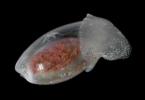
underside

more orange
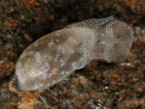
young, 3.5 mm
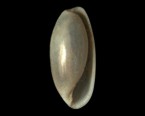
shell
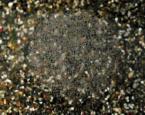
egg mass
_______________
GALLERY

Roxaniella pittmani (Too, Carlson, Hoff & Malaquias, 2014)
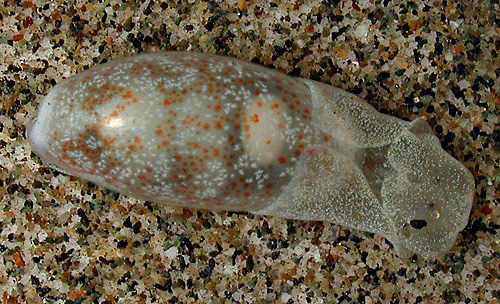
| Maximum size: 18 mm
(extrapolated from shell length). Identification: This species has a slender, tapered, transparent shell. Fine, wavy spiral striae are largely confined to the apex and base where they become more prominent with age. In fully mature animals, the outer lip becomes slightly thickened. The animal is translucent-gray flecked with white and orange-brown. Natural history: Roxaniella pittmani is a common species that may be found in mixed habitats, sand channels and Halimeda kanaloana beds at depths of < 1 to 29 m (< 3 to 95 ft). However it is more common in H. kanaloana beds than elsewhere. It occurs at highly protected to moderately exposed sites. It is a nocturnal species that buries itself in sand during the day and lays a spherical, pale pink egg mass that is probably anchored in algal turf in the field. (Note 1) The eggs hatch in about three days in the laboratory. Distribution: Big Island, Maui, Oahu, Kauai and French Frigate Shoals: also recorded from the Philippines. Taxonomic notes: This species is listed in Severns, 2011 as Atys multistriatus. Shells are present in various mixed lots at the Bishop Museum. Photo: CP: 10 mm: Hekili Point, Maui; Oct. 5, 2002. Observations and comments: Note 1: On Oct. 5, 2002 an animal was observed laying eggs in a sand bottomed dish. It remained beneath the sand except for the front of the head and the egg mass was inflated "balloon fashion" by puffs of eggs "blown" into the mucous envelope from between the head and the mantle on the right side. It remained buried beneath the egg mass for some time after laying. However, in Oct. and Nov., 2004 small aggregations of half a dozen or so individuals were observed in the field near egg masses anchored in algal turf that were comparable to those laid in the laboratory. In addition, such egg masses have not been observed in the field anchored in sand. That supports a preference for laying in algal turf. |
| Thumbnails |
Species
list |
Family | Next species | Top |